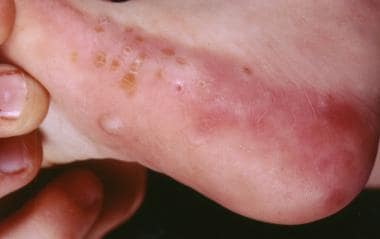Background
Infantile acropustulosis is a recurrent, self-limited, pruritic, vesicopustular eruption of the palms and the soles occurring in young children during the first 2-12 months of life (see the image below). First described in 1979, infantile acropustulosis is probably much more common than the scarcity of reports would imply. [1, 2]
Pathophysiology
The pathophysiology and etiology of infantile acropustulosis are unknown. Many cases of infantile acropustulosis are preceded by well-documented or suspected scabies infestation, and a scabies id reaction has been suggested. [3, 4, 5, 6] The condition is fairly common among children adopted from foreign countries, a setting where scabies might be suspected. [7] More often, cases of infantile acropustulosis occur despite scabies having been thoroughly ruled out.
Bacterial and viral culture results are consistently negative, and negative immunofluorescence results suggest that infantile acropustulosis is not an antibody-mediated autoimmune process.
An association with atopic dermatitis (atopy) has been noted. [7, 8]
The most recently recognized cause of infantile pustulosis is a deficiency of interleukin 1 receptor antagonist (DIRA), which is a recessive syndrome caused by a loss of function mutation resulting in unopposed action of interleukin 1 and life-threatening systemic inflammation. [9] This should be distinguished from localized infantile acropustulosis.
Etiology
The cause of infantile acropustulosis is unknown. Scabies as a preceding or concomitant infestation in the same patient is well-documented in some cases. Many children are undoubtedly misdiagnosed with scabies and initially treated with lindane or permethrin without any confirmatory scrapings. It has been postulated that infantile acropustulosis is a cutaneous hypersensitivity reaction to antigens associated with scabies infestation. [10] No other infectious agent has been documented. Clinical response to a therapeutic trial of dapsone has been suggested to help differentiate between a scabetic and nonscabetic cause of the eruption; however, more data are needed. [11]
Some studies suggest that acropustulosis and neonatal eosinophilic pustular folliculitis are associated and may be manifestations of the same underlying disease. [12, 13]
Epidemiology
Frequency
The exact incidence of infantile acropustulosis is unknown. One study from Israel reported 25 cases of infantile acropustulosis in a 9-year period, suggesting that this is not as uncommon as once thought. [14]
Race
Early reports suggested a predominance of African Americans for infantile acropustulosis. Now, acropustulosis of infancy is believed to affect all races equally.
Sex
Early reports suggested a male predominance for infantile acropustulosis. Larger series have since shown an equal distribution between males and females. [5, 14]
Age
Although children as old as 9 years have been reported to have infantile acropustulosis, acropustulosis of infancy typically begins between the first 2-12 months of life. [14] Resolution by age 3 years is the norm.
Prognosis
Prognosis is for infantile acropustulosis excellent. Generally, the bouts of pruritic vesicopustules decrease in severity with successive outbreaks and resolve by age 2-3 years, with definite resolution by age 9 years.
-
Lateral and plantar aspects of the foot with a combination of intact acute vesicles and brownish hyperpigmentation of old vesicles.
-
Pustules on the dorsal hands of a 1-year-old child.
-
Scattered new and resolving pustules on the dorsal feet.





